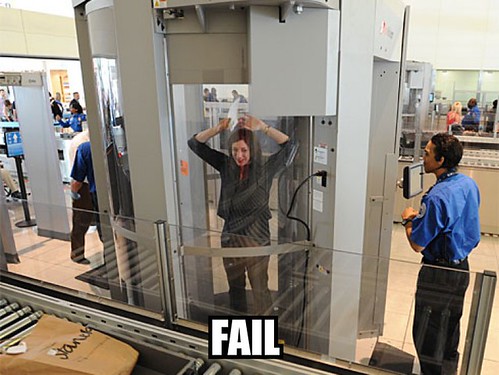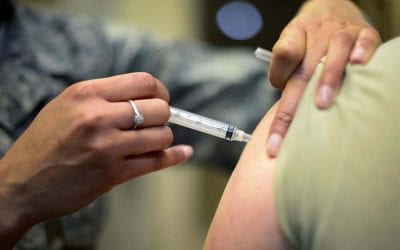On Wednesday, November 2, TSA Administrator John Pistole testifying at a Senate hearing told senators that TSA would finally conduct an independent study of their backscatter x-ray full body scanners.
Now that a new Inspector General report is about to be released, which will reportedly validate TSA’s job of inspecting, maintaining and operating its Advanced Imaging Technology (AIT) full body scanners, it sounds as if Mr. Pistole is trying to back away from keeping his promise to have an independent study to determine the health effects of the full body scanners on air passengers.
Senator Susan Collins, (R-Maine), who requested the independent study, said,
“I hope the Obama administration is not backing away from an independent study. What I asked for, and what the administrator committed to, was an independent study on the health effects of AIT machines, not just a study on whether TSA is doing an adequate job of inspecting, maintaining and operating AIT machines, which I understand is the approach of the inspector general’s report.”
Apparently Mr. Pistole doesn’t understand that American’s are questioning TSA’s basic premise that full body scanners are safe.
Dr. Michael Love apparently doesn’t think the backscatter x-ray full body scanners are safe. Dr. Love runs an x-ray laboratory at the Department of Biophysics and Biophysical Chemistry at the Johns Hopkins University School of Medicine has stated,
“They [TSA] say the risk is minimal, but statistically someone is going to get skin cancer from these [backscatter] x-rays.”
Speaking to the press, Dr. Love went on to say,
“No exposure to x-ray is considered beneficial. We know X-rays are hazardous, but we have a situation at the airports where people are so eager to fly that they will risk their lives in this manner.”
Dr. Love isn’t alone. A group of scientists at the University of California, San Francisco (UCSF) have raised concerns about the “potential serious health risks” from the full body scanners, in a letter the group sent to the White House Office of Science and Technology.
Speaking for his colleagues, Biochemist, Dr. John Sedat said,
“While the dose would be safe if it were distributed throughout the volume of the entire body, the dose to the skin may be dangerously high.”
The UCSF scientists said the x-rays from the backscatter x-ray full body scanners could pose a risk to all travelers and especially those over the age of 65, pregnant women and their unborn babies, HIV-positive travelers, and cancer patients.
Apparently all men are also vulnerable as the male sexual organ skin is very thin.
According to the American College of Radiology (ACR), “The decision to have an x-ray exam is a medical one, based on the likelihood of benefit from the exam and the potential risk from radiation.” Moreover, they advise, “If you have had frequent x-ray exams and change healthcare providers, it is a good idea to keep a record of your x-ray history for yourself.” That way, your new healthcare provider, once giving your history, will have a solid basis for their recommendation based on your radiological history.
The thing is, the effect of x-ray radiation on our bodies is cumulative, and since TSA has no idea of each passengers physical health, or their previous exposure to radiation, they can’t possibly say their backscatter x-ray full body scanners are safe for passengers.
One of the principal precepts of medical ethics, a precept which all medical students are taught in medical school, a fundamental principle for medical services around the globe is,
Primum non nocere, “First, do no harm.”
It’s unfortunate that TSA doesn’t subscribe to this fundamental ethical principle. If they did, they would never have installed backscatter x-ray full body scanners, in the first place.
While discussing the full body scanners during my recent journey in the Middle East with fellow travelers, I found that more often than not, in a perverse way, we agreed with Administrator Pistole, that there was really no need to test the full body scanners for safety.
Mr. Pistole thinks it’s a waste of time to make the tests because he believes the ones already run prove the scanners are safe. We disagreed, yet felt the tests were unnecessary, since it’s clear the scanners can’t perform the job for which they were purchased and installed, to detect terrorists attempting to bring weapons and/or explosives on board planes.
In my column, TSA: Myths and Facts, I explained, for example, that neither type of full body scanner is capable of detecting threats like the one posed by “Panty bomber” Umar Farouk Abdulmutallab, who tried to blow up a plane with PETN explosive powder sewn in his underwear. The PETN used by Abdulmutallab, has essentially the same density as the clothing containing it, and is therefore invisible to the scanners. Moreover, the scanners also are unable to detect explosives secreted in the body cavities of men and women, because the scanners can’t see there.
We therefore concluded the scanners, even if safe, are a colossal waste of money, that the purchase of new units should be canceled, and currently installed units removed from airports, and that current scanners use is actually making us less safe, because other detection methods might actually discover terrorists trying to board with such explosives.
After many years working in corporate America as a chemical engineer, executive and eventually CFO of a multinational manufacturer, Ned founded a tech consulting company and later restarted NSL Photography, his photography business. Before entering the corporate world, Ned worked as a Public Health Engineer for the Philadelphia Department of Public Health. As a well known corporate, travel and wildlife photographer, Ned travels the world writing about travel and photography, as well as running photography workshops, seminars and photowalks. Visit Ned’s Photography Blog and Galleries.


